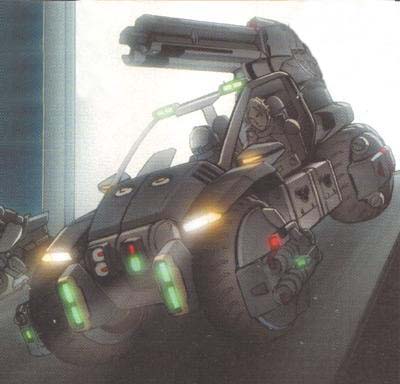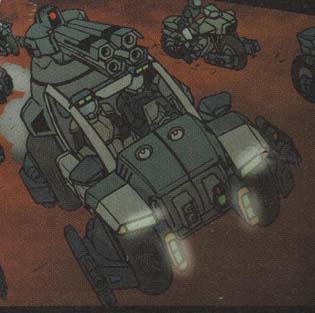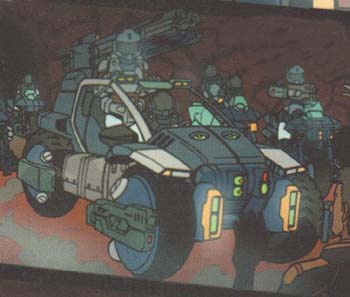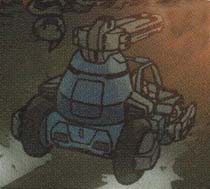M-310 ALL-TERRAIN COMMAND SUPPORT VEHICLE "BATTLE BUGGY"
(Version 1.0
-
Last updated: 03/08/06)
- Background and RPG Statistics by Kenneth Olson
- Based on an original mecha design by Tommy Yune, Jason
Waltrip, John Waltrip, and Omar Dogan
- Published in Wildstorm Comics
"Robotech Prelude to the Shadow Chronicles" Volume 5
BACKGROUND
 In the later stages of the Sentinel campaign, the Robotech
Expeditionary Forces (REF) began to introduce large number of armored
Cyclone riders. Initially, the Cyclone was designed exclusively as a emergency vehicle to be used if a Veritech pilot was
downed behind enemy lines. However as the war progressed against the Invid
Regent, the REF began to appreciate the unique combat
capabilities of the Cyclone and issued the mecha as standard
equipment to a significant number of ground troops. Initially,
company sized units of Cyclone riders were commanded from either an
officer piloting in a Destroid or in the air from a VFA-6 series Veritech fighter. However, REF command felt that having an
officer removed from his troops in such a fashion defeated the purpose of forming a small highly
mobile and easy to hide force. The high command began to
investigate the possibility of designing a command vehicle which would
better compliment a small group of Cyclone Riders.
In the later stages of the Sentinel campaign, the Robotech
Expeditionary Forces (REF) began to introduce large number of armored
Cyclone riders. Initially, the Cyclone was designed exclusively as a emergency vehicle to be used if a Veritech pilot was
downed behind enemy lines. However as the war progressed against the Invid
Regent, the REF began to appreciate the unique combat
capabilities of the Cyclone and issued the mecha as standard
equipment to a significant number of ground troops. Initially,
company sized units of Cyclone riders were commanded from either an
officer piloting in a Destroid or in the air from a VFA-6 series Veritech fighter. However, REF command felt that having an
officer removed from his troops in such a fashion defeated the purpose of forming a small highly
mobile and easy to hide force. The high command began to
investigate the possibility of designing a command vehicle which would
better compliment a small group of Cyclone Riders.
The M-310 All-Terrain Command Support Vehicle
(aka 'Battle Buggy') was designed to allow company grade Cyclone
officers to command their troops from the field. Although
the M-310 can not transform, the vehicle does share many of the same
weapon systems and vehicle characteristics as the Veritech
Cyclone. The M-310 is normally manned with a crew of two with
the commander/driver operating from the left seat and a weapon systems
operator on the right, although any of the vehicle systems can be operated
from
either position. However, in an emergency situation the M-310 could
carry several
additional personal on the outside of the drivers compartment and in
the rear. The
vehicle is powered by two standard Protoculture cells which provide
power to an electric motor which is capable of propelling the vehicle
up to 150 kph on paved roads or 80 kph cross country. The vehicle
is armored similarly to the standard Veritech Cyclone with a low mass
Chobham plating. The armor is capable of withstanding most small
arms fire, but medium and heavy anti-mecha weaponry will quickly
destroy the unit. In addition, operators of the M-310 are
exposed to enemy fire as they are not completely enclosed by the
vehicle and thus are required to wear CVR body armor to provide
personnel protection when deploying the vehicle in a combat area.
The M-310's primary armament is a turret
mounted EP-43 quad-common particle beam cannon. Each barrel
fires 2.5 MJ bursts (10 MJ combined) at a
maximum sustained rate of 20 bursts per minute out to an effective combat
range of 2.0
km. The cannon can capable of a full 360 degree traverse in
azimuth and from -30 degrees to +90 in elevation with slew times of
just under 30 degrees per second. The cannon is powered from its
own dedicated two cell protoculture energizer providing an estimated
1,000 shots before needing replacement. The weapon can be
operated by
either crew members in the vehicle; however, normal operation allows
the driver / commander to designate targets (left seat) and then the
gunner (right seat) to engage. The turret system was
designed to mount a variety of weapon systems. Instead of the
standard EP-43 Quad-barreled particle gun a twelve tube multi-missile
launcher can be placed in the turret instead (see notes in weapons
section).
Each of the four tires on the M-310 is capable
of
mounting a single modular weapon system; although, under most combat
situations only the front two tires are mounted with weapon systems
because of the rear tires more limited field of fire. The two
most common weapon systems are derivatives of those found on the
standard Cyclone: the EP-37B carbine and the GR-97 mini-missile
system. However, developmental versions of some of the other arm
mounted Cyclone weapon systems were built and tested.
Approximately 200 vehicles were built and deployed from 2038 until the
conclusion of the 3rd Robotech
War in July of 2044. The M-310 proved to be a solid design with
only approximately 25 of their total destroyed as a result of enemy
action during the course of their six
year operational deployment. Unfortunately, the open air driver's
compartment proved to be the greatest flaw of the design as most of the
casualties suffered by M-310 operators were as a result of direct
strikes to the pilot. The M-310 was deployed in all of the later
Sentinels operations and even participated during the final REF assault
on Terra. However, the M-310 was most famously used by Admiral
Rick Hunter during the REF's successful invasion of Optera in 2042 to
bring about an end of the REF civil war.
RPG STATS
- Vehicle Type: M-310 All Terrain Command Vehicle
- Class: Two axle all-terrain command vehicle
Manufacturer: Robotech Expeditionary Forces
Crew: 2 (Commander / Driver on right and Weapons Officer in
left) a third person can sit between the two crew members if necessary
- Service History: Served with the REF from 2038
until the conclusion of the Third Robotech War (July 2044)
MDC BY LOCATION:
| Location |
M-310
"Battle Buggy"
|
Turret Mounted EP-43 / MM-12
|
75
|
Headlight / Sensors
|
25
|
| Front Tires (2) |
10 each |
Rear Tires (2)
|
10 each
|
| Storage Boxes (4) |
2 each |
| * Main Body |
100
|
| Reinforced Driver's Compartment |
50
|
NOTES:
- * Destruction of the Main Body will immobilize the unit.
- **Reinforced Pilots Compartment provides only limited protection
to the crew. 40% of all attacks directed to this location will
strike the operators
- If the GM so desires the unit to have MDC values in line with
those published in Palladium books for the Cyclone, the values
presented should be multiplied by roughly a factor of three.
 SPEEDS:
SPEEDS:
- MAXIMUM SPEED:
- Road: 150 kph
- Cross-Country: 50 kph
- 10-deg upslope: 40 kph
- 60-deg upslope: 25 kph
- Water Depth (1.5m): 10 kph
- ACCELERATION:
- 0-100 kph: 8 seconds with typical combat load
- OBSTACLE:
- Vertical: 1.0 m
- Trench: 3.0 m
- SPACEBORNE OPERATIONS:
- N/A
-
STATISTICAL DATA:
- LENGTH:
- 4.8 m
- WIDTH
- 3.7 m
- HEIGHT
- Main Body: 2.0 m
- Top of Turret: 2.9 m
- GROUND CLEARANCE
- 0.5 m
- WEIGHT:
- 800 kg empty
- 1,200 kg with combat load
- CARGO:
- Four standard REF cargo cases mounted underneath the drivers
compartment
- POWER PLANT:
- 1x RRG-27A Miniaturized Protoculture-cell energizers providing
nearly 10 MW of electrical power. The power plant provides power
to the Siemens electric motor and to the onboard weapon systems.
- ENGINE:
- [Main]: 1x SIEMENS PROTOCULTURE / ELECTRIC MOTOR: The
M-310 has six-speed automatic transmission with 500 horsepower (381 kW)
and 300 lb-ft (407 N*m) of torque.
- FUEL CAPACITY:
- 2 standard canisters of Protoculture, providing power for an
estimated 300 hours of operation
WEAPON SYSTEMS:
- 1 x EP-43 QUAD-BARRELED PARTICLE GUN: The primary
weapon on the M-310 is a turret mounted quad-barreled particle beam
cannon. Each barrel fires 2.5 MJ bursts (10 MJ combined) at a
maximum sustained rate of 20 per minute out to an effective combat
range of 2.0
km. The cannon can capable of a full 360 degree traverse in
azimuth and from -30 degrees to +90 in elevation with slew times of
just under 30 degrees per second. The cannon is powered from its
own dedicated two cell protoculture energizer providing an estimated
1,000 shots before needing replacement. The weapon can be
operated by
either crew members in the vehicle; however, normal operation allows
the driver / commander to designate targets (left seat) and then the
gunner (right seat) to engage.
- PRIMARY PURPOSE: Assault
- SECONDARY PURPOSE: Anti-Mecha
- RANGE: 2000 m
- DAMAGE: 2D6 per cannon or 1D6*10 from all four
cannons firing simultaneously
- RATE OF FIRE: Short bursts up to 5 times per melee
- PAYLOAD: Effectively unlimited
- NOTES: If the GM so desires to have the this
weapon more in line with the Cyclone weapon systems published in
Palladium books, one should multiply the damage by a factor of x2
- (optional) 1 x MM-12
TURRET MOUNTED MULTI-MISSILE SYSTEM: The turret system was
designed to mount a variety of weapon systems. Instead of the
standard EP-43 Quad-barreled particle gun a twelve tube multi-missile
launcher can be placed in the turrent instead. The system has
similar traverse capablitys; however, because of the heavier weight can
only slew at 20 degrees per second. Each tube can hold a single
hammerhead short range missile or the launcher can be reconfigured to
hold up to four GR-105 mini missiles instead. However, if the
system is configured with mini-missiles each missile tube can only fire
one of the four subdivided missiles in any given volley.
- PRIMARY PURPOSE: Assault
- SECONDARY PURPOSE: Anti-Mecha
- RANGE HAMMERHEAD: 5200 m
- RANGE GR-105:
800 m
- DAMAGE: 1D6*10 (Plasma) or 1D4*10 (High Explosive)
- DAMAGE GR-105:
3D6 MDC
- RATE OF FIRE: In volleys of 1, 2, 4, 6, 8, or all 12
- PAYLOAD: 12 Short Range Hammerhead missiles, or
48 GR-105 mini missiles
- NOTES: The
weapons can traverse 240 degrees in azimuth, each cannon can only fire
in the 240 degree azimuth sector away from the main body of the
vehicle, and up to 45 degrees in elevation
- 4 x WHEEL MOUNTED MODULAR WEAPON
SYSTEMS: Each of the four tires on the M-310 is capable of
mounting a single modular weapon system; although, under most combat
situations only the front two tires are mounted with weapon systems
because of the rear tires more limited field of fire. The two
most common weapon systems are derivatives of those found on the
standard Cyclone: the EP-37B carbine and the GR-97 mini-missile
system. However, developmental versions of some of the other arm
mounted Cyclone weapon systems were built and tested.
- EP-37B 60 MM PARTICLE BEAM
CARBINE: The EP-37B is a carbine version of the EP-37
rifle issued to most Cyclone pilots. The gun is capable of firing
semi-automatically either 650 KJ or 1.25 MJ bursts out to an effective
combat range of nearly 1.0 kilometer. The weapon can be detached
from the wheel housing in an emergency and used as a personnel sidearm
in approximately 5 seconds.
- PRIMARY PURPOSE:
Assault
- SECONDARY PURPOSE:
Anti-Aircraft / Anti-mecha
- RANGE: 1000 m
- DAMAGE (low power / high power): (1D4/1D6) for each
single shot, (2D4/2D6) for each short burst, or (4D4/4D6) for each long
bursts
- RATE OF FIRE: Single shots or bursts equal to the
combined attacks of the pilot
- PAYLOAD:
Effectively unlimited when powered from the vehicles main Protoculture
energizer. The gun's onboard clip can fire 15 single shots, 5
short bursts or 1 long.
- NOTES: If the GM so desires to have the this
weapon more in
line with the Cyclone weapon systems published in Palladium books, one
should replace the EP-37B with a slightly underpowered and under ranged
version of the EP-37.
- GR-97 SCORPION MISSILE
LAUNCHER: Two Scorpion missiles are mounted in each wheel
missile launcher. The missiles posses their own passive IR
seekers or can be guided directly from the M-310 through the onboard
laser designation system. Each GR-97 can be removed in an
emergency and mounted on a Cyclone; however, the process would take
several minutes.
- PRIMARY PURPOSE:
Assault
- SECONDARY PURPOSE:
Anti-mecha
- RANGE: 1,700 m
- DAMAGE: 5D6
MDC
- RATE OF FIRE:
Single shots or in volleys of 2
- PAYLOAD: 2
missiles per launcher
- HAND TO HAND COMBAT:. As a vehicle the M-310
can not engage in physical combat as a mecha can. However,
the vehicle can ram or crush items in its path.
- Ram (50 kph): 3D6 MDC
- Ram (100 kph): 6D6 MDC
- Crush (only effective against small targets): 1D4 MDC
STANDARD EQUIPMENT FOR THE M-310 BATTLE BUGGY:
-
 ACTIVE SENSOR
JAMMER: Westinghouse ALQ-257(V) internal ECM providing
broadband protection. Estimated system effective radiative power
30 dBW
ACTIVE SENSOR
JAMMER: Westinghouse ALQ-257(V) internal ECM providing
broadband protection. Estimated system effective radiative power
30 dBW
- COMBAT COMPUTER HP DIGITAL BALLISTIC COMPUTER:
The combat
computer aids the gunner to identify and track specific enemy
targets. The combat computer stabilizes the main gun while the
vehicle is in motion.
- EXTERNAL AUDIO PICKUP: Range: 300 ft (91.5 m). A sound
amplification system that can pick up normal conversation up to 300
feet away.
- HEAT AND RADIATION SHIELDS: Special shielding prevents the
penetration of life threatening head and radiation. A radiation
detection and alarm system are linked with the shields and will sound
an alarm if there is a rupture in the shields and what the levels of
radiation are.
- HOMING SIGNAL: The M-310 is equipped with a homing device
that enables rescue teams
to locate a disabled vehicle. The range of the signal
is 400 miles (640 km). Most REF ships and veritechs can locate and
track a homing signal, and the onboard computers will automatically
notify their pilots if such a signal is detected.
- INFRA-RED COUNTERMEASURES: Westinghouse QRC-100
providing protection from IR guided missiles
- INFRA-RED WARNING RECEIVER: OlDelft Infra-red
Warning Receiver (IRWR) providing rear aspect coverage from IR guided
missiles
- LASER RANGE FINDER / TARGETING SYSTEM: Thomson LT-5
multi-frequency laser ranger and designator (Range 30 kilometers)
- LOUDSPEAKER: A loudspeaker system is built into the craft,
which can be used to amplify the pilot's voice up to 90 decibels.
- OPTICS (INFRARED): Phillips All-View multi-band
camera system range 1000 meters. This optical system projects a
beam of infrared light that is invisible to the normal eye, but
detectable by the mecha's sensors. The system allows the pilot to
detect hidden/concealed objects by their IR reflectiveness. The beam
will be visible to anyone with IR sensitive optics, however.
- OPTICS (NIGHTVISION): Phillips All-View multi-band camera
system range 1000 meters. A passive light image intensifier that
emits no light of its own, but relies on ambient light which is
electronically amplified to produce a visible picture
- OPTICS (THERMAL IMAGER): Range 2000 meters. A passive
optical heat sensor that detects infrared radiation projected by warm
objects and converts that data into a false-color visible image. The
system enables the pilot to see in the dark, in shadows, and through
smoke, and also adds a +10% bonus to pilots using a tracking skill.
- RADIO/VIDEO COMMUNICATION: Long range, directional
communications system with satellite relay capabilities. Range: 600
miles (960 km) or can be boosted indefinitely via satellite relay.
- RADAR (SHORT RANGE / FIRE CONTROL): Hughes APG-118
X-band pulse-Doppler, providing spherical long-range detection and
tracking of targets at all altitudes. (Range 30 km against a 0 dBsm
"Invid sized" target)
- RADAR WARNING RECEIVER: Marconi Radar Warning
Receiver (RWR)
- SELF-DESTRUCT: To prevent capture of the vehicle, the
pilot can activate the M-310
self-destruct system, which will cause the vehicle to explode after a
delay of up to 60 minutes (time is set by the pilot). The explosive
damage is contained within a 20 foot (6 m) area and inflicts 1D6x10
M.D. to everything within the radius of the explosion. All internal
systems are obliterated.
- SMOKE DISPENSERS (M250): 2 x 6 barrel smoke
dischargers (24 rounds each) mounted in the rear. Smoke canisters
can be discharged from the rear of the unit and provide cover for a 20
meter radius.
- STANDARD SURVIVAL KIT: All REF vehicles come equipped with
a
portable survival kit. Inside the small reinforced box is a
medium-sized flashlight, two hand flares, one rocket flare, a compass,
infrared distancing binoculars, a small mirror, a pocket knife,
dehydrated and concentrated food (can be stretched into a five day
supply for one person) and basic first aid items (aspirin, bandages,
disinfectants, etc.)
COMBAT BONUSES FOR M-310 "BATTLE BUGGY":
- Number of attacks equal to the combine number of the pilot,
gunnery officer, and commander
- +2 to strike targets
- +1/+2/+3 to dodge above 20/40/60 kph.
Random Hit Locations
 When there is an equal chance of
hitting both sides from 1D6
When there is an equal chance of
hitting both sides from 1D6
- 1-3 hits the right side
- 4-6 hits the left
When there is a preferred side, roll
1D10
- 1-8 hits the preferred side
- 9-10 hits the opposite side
| M-310 "Battle Buggy" |
FRONT
|
BACK
|
SIDES
|
TOP
|
BOTTOM
|
| Turret
(Main Body) |
01-30 |
01-80 |
01-30 |
01-40 |
- |
| Headlight /
Sensors (Main Body) |
31-40 |
- |
31-33 |
41-43 |
01-05 |
| Front Tires
(Main Body) |
41-48 |
81 |
34-44 |
44-48 |
06-15 |
| Rear
Tires (Main Body) |
49-52 |
82-90 |
45-55 |
49-53 |
16-25 |
| Storage
Boxes (Main Body) |
53-55 |
91-92 |
56-60 |
54-55 |
26-40 |
| Main Body
(Driver's Compartment) |
56-80 |
93-96 |
61-80 |
56-75 |
41-00 |
| Driver's
Compartment* |
81-00 |
97-00 |
81-00 |
76-00 |
- |
|
* 40%
Chance that attacks at Drivers Compartment will strike on of the
operators |
SOURCES USED IN CREATION OF DOCUMENT
- Palladium Books "The Sentinels": AAT-30 and AAT-40
- Robotech Technical Files: M-199, M-304, and M-306
- Wildstorm Comics: "Prelude to the Shadow Chronicles" Volume 4
Back to Mecha Home
 In the later stages of the Sentinel campaign, the Robotech
Expeditionary Forces (REF) began to introduce large number of armored
Cyclone riders. Initially, the Cyclone was designed exclusively as a emergency vehicle to be used if a Veritech pilot was
downed behind enemy lines. However as the war progressed against the Invid
Regent, the REF began to appreciate the unique combat
capabilities of the Cyclone and issued the mecha as standard
equipment to a significant number of ground troops. Initially,
company sized units of Cyclone riders were commanded from either an
officer piloting in a Destroid or in the air from a VFA-6 series Veritech fighter. However, REF command felt that having an
officer removed from his troops in such a fashion defeated the purpose of forming a small highly
mobile and easy to hide force. The high command began to
investigate the possibility of designing a command vehicle which would
better compliment a small group of Cyclone Riders.
In the later stages of the Sentinel campaign, the Robotech
Expeditionary Forces (REF) began to introduce large number of armored
Cyclone riders. Initially, the Cyclone was designed exclusively as a emergency vehicle to be used if a Veritech pilot was
downed behind enemy lines. However as the war progressed against the Invid
Regent, the REF began to appreciate the unique combat
capabilities of the Cyclone and issued the mecha as standard
equipment to a significant number of ground troops. Initially,
company sized units of Cyclone riders were commanded from either an
officer piloting in a Destroid or in the air from a VFA-6 series Veritech fighter. However, REF command felt that having an
officer removed from his troops in such a fashion defeated the purpose of forming a small highly
mobile and easy to hide force. The high command began to
investigate the possibility of designing a command vehicle which would
better compliment a small group of Cyclone Riders. SPEEDS:
SPEEDS: ACTIVE SENSOR
JAMMER: Westinghouse ALQ-257(V) internal ECM providing
broadband protection. Estimated system effective radiative power
30 dBW
ACTIVE SENSOR
JAMMER: Westinghouse ALQ-257(V) internal ECM providing
broadband protection. Estimated system effective radiative power
30 dBW  When there is an equal chance of
hitting both sides from 1D6
When there is an equal chance of
hitting both sides from 1D6